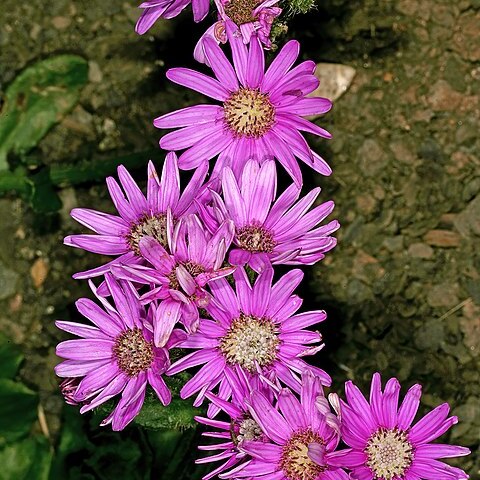Perennial herb; flowering stems up to 0.7 m high, from stout, woody stock, several from crown, often decumbent at base, then erect, nearly glabrous to softly glandular-pilose, simple below, forking above into corymbose inflorescence, sparsely leafy. Leaves mostly in basal rosettes; blade obovate to elliptic, ± 400 x 110 mm, tapering to broad, flat petiole-like clasping base, apex subacute to obtuse, margins pinnately or sinuately lobed, lobulate or coarsely deltoid-toothed, margins of lobes often denticulate; glandular-pubescent, glabrous or lightly cobwebby below; stem leaves smaller, passing into bracts, base subauricled, clasping. Heads radiate, 12-15 x 12-15 mm, few to many, corymbosely or sometimes subracemosely arranged. Involucral bracts 16-20, (9-)10(-12) mm long, glandular-pilose to glabrous; calyculus bracts very few, short. Flowers: ray florets 8-12-14(-20); ray and disc florets deep pink to purple; Sep., Oct., Jan. Fruit with cypsela (and ovary) cylindric, pubescent between ribs.
Perennial herb, up to 0.75 m high, rootstock stout, woody. Stems several, decumbent basally, then erect, simple below, ± glabrous to glandular-pilose, sparsely leafy. Leaves mostly radical, rosetted, ± 100-200 x 20-40 mm, spathulate or elliptic, base broad, flat, petiole-like, clasping, margins dentate to lobed, mostly glandular-pubescent; upper leaves smaller, narrower, sessile. Inflorescence corymbose. Capitula few-many, disc and rays (8-20) pink to purple; involucral bracts 16-20, ± 10 mm long, glabrous to glandular-pilose; calyculus bracts very few, short. Flowering time mostly July-Jan. Cypselae cylindrical, ± 3 mm long, hairy between ribs.
Perennial herb, up to 0.7 m high. Radical leaves mostly rosetted, glandular-pubescent, glabrous or lightly cobwebby below, with long, broad, flat petiole, margins deeply lobed or toothed. Heads radiate, rays 8-12-14(-20); involucral bracts 16-20, (9-)10(-12) mm long. Achenes pubescent between ribs. Flowers deep pink to purple.
Glandular-hairy, rosulate perennial to 50 cm. Leaves oblanceolate, lobed to lacerate. Flower heads radiate, several in lax, terminal corymbs, magenta.

